Top News

May 7, 2016 Ryukyu Shimpo
On the morning of May 7, former Prime Minister Yukio Hatoyama visited the sit-in-protest site in front of the gate of Camp Schwab at Henoko in Nago. He encouraged citizens staging a protest against the construction of a new U.S. base, which is part of plans to relocate the U.S. Marine Corp Air Station Futenma in Ginowan.
About 150 protesters raised their fists, shouting, “remove concrete blocks at once.” Concrete blocks used for initial surveying for landfill for the base are being removed from Oura Bay as part of a settlement in a lawsuit over the Henoko relocation.
Hatoyama said, referring to the work being carried out to remove the floats, “Your everyday activities are at last bearing fruit. On this occasion when the construction work is suspended, I want you to have a rest to prepare for the next struggle.”
“I am striving to block the construction of the base in Henoko with you,” he added.
A citizen handed the former prime minister a blue T-shirt bearing the message, “the only way to win – never give up.”
Hatoyama wore the T-shirt while speaking to the sit-in protesters.
In the afternoon, he visited Takae district in Higashi to encourage citizens staging a protest against the construction of Helipads by the U.S. military.
(English translation by T&CT)
Go to Japanese

May 5, 2016 Ryukyu Shimpo
On May 5, the last day of the 42nd Naha Dragon Boat Festival, Naha’s team won the official race for the first time in three years. Many spectators gathered at the festival and cheered for the racers.
Teams from Tomari, Kume and Naha competed in the official race. At first the Tomari team took the lead, but the team from Naha passed them in the first turn, and kept the lead until the end. The Naha team’s time was 5 minutes and 58.4 seconds. The team leader said, “I’m happy we won with our strategy.”
The winners in the general section races were JTA Group in the A Block at 5 minutes and 9.99 seconds, and Lequio Wing in the B Block at 4 minutes and 50.08 seconds
(English translation by T&CT and Erin Jones)
Go to Japanese
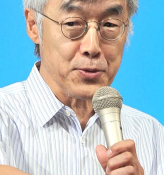
May 4, 2016 Ryukyu Shimpo
On May 3, at the Naha Civic Hall, the Okinawa Constitution Promotion Council, the Okinawa Human Rights Association, and the Okinawa branch of the Japan Scientists’ Association jointly held the 2016 Constitution Lecture Event in honor of Japan’s Constitution Day. This event, the fifty-first annual Constitution Lecture Event, was held at a time when Japan’s political situation seems to be heading in the direction of constitutional change. At the event, around 1,500 participants (organizer estimate) pledged to uphold Article 9 of the constitution.
Across Okinawa, events promoting both constitutional preservation and constitutional change were held, providing opportunities for many people in Okinawa to consider the constitution.
At the Constitution Lecture Event, Genichiro Takahashi, writer and professor in the Faculty of International Studies at Meiji Gakuin University, gave a lecture titled “Democracy: An Unfinished Project.” Professor Takahashi spoke of the importance of not making generalizations, telling the audience that steps forward can only be made with our own feet. He expressed hope that Okinawans will honor their own unique view of the constitution, one different that of people in other parts of Japan.
The event also included a panel discussion featuring Professor Takahashi, Jinshiro Motoyama and Yuri Ishibashi of SEALDs RYUKYU, and Mayumi Shiroma of Mothers Against the Security Laws @Okinawa. The four discussed such topics as society’s views on young people and mothers raising their voices and political activities that can fit into people’s everyday lives.
The group Okinawa Performers Choosing to Renounce War also performed a reading on the theme of Article 9 and Okinawa. They called for the repeal of the new security legislation and the cancellation of construction of a new military base in Henoko, Nago.
The event also featured the reading of a constitutional pledge, stating: “As sovereigns with the responsibility to realize the attainment of an as-of-yet incomplete democracy, we vow to continue raising our voices and to create peace spreading from Okinawa to the rest of the world.”
(English translation by T&CT and Sandi Aritza)
Go to Japanese

May 1, 2016 Ryukyu Shimpo
At 7:20 a.m. on April 30, the Okinawa Defense Bureau began the process of removing the floats and oil fence that had been put up to demarcate the off-limits zone in the bay off the coast of Henoko. The off-limits zone was established to facilitate the construction of a new U.S. military base in Henoko, Nago as part of the relocation of U.S. Marine Corps Air Station Futenma. According to the Okinawa Defense Bureau, it will take several weeks to complete the removal process.
The float removal is part of a settlement in a lawsuit over the Henoko relocation. On April 30, when the float removal process began, Governor Takeshi Onaga told the press that while the float removal is a step in the right direction, he will continue to push for the removal of the buoys and anchor blocks set up to facilitate the related drilling survey in the bay, as well as the abolition of the temporary restricted zone in its entirety.
Okinawa Defense Bureau work barges appeared off the coast of Henoko just after 7 a.m. and began to remove the oil fence. Shortly after 2 p.m., the barges disconnected a portion of the floats near the Sedake coast and dragged them onto the shore.
In the afternoon, protesters opposing the new base construction went out in four protest boats and twenty-five kayaks. They entered the off-limits zone, calling for spud barges and concrete blocks to be removed from the bay as well.
(English translation by T&CT and Sandi Aritza)
Go to Japanese

May 1, 2016 Ryukyu Shimpo
By Naoki Isa in Hue, Vietnam
On the evening of April 29, Hue festival 2016 opened in Hue, the ancient capital of Vietnam. The Okinawan traditional dance troupe led by performing artist Hisae Takamine appeared on the stage at the opening ceremony held in front of the main temple of the royal palace of Hue.
Ryukyu dances, including Nubui Kuduchi and Hatoma Bushi, Karate dance Bu no Mai, and Lion dance Marimai, which is a revived performing art of the Ryukyu Kingdom, were performed.
Audiences enjoyed witnessing Okinawan performing arts, which provided a way of communicating beyond the language barrier. They gave a round of applause for the performers.
On April 30, the troupe performed dances and introduced Okinawan culture to Vietnamese students and artists at a workshop held in royal theater in the palace and organized by the Music Institute of Hue.
The Okinawan participants listened to Vietnamese traditional music performed by students and artists from the Music Institute of Hue.
At the finale of the event, the members from Okinawa and Vietnam performed Okinawan music Asadoyayunta together.
Associate Prof. Dr. Ta Quang Dong – Vice Rector of Hue Academy of Music said, “Vietnam and Okinawa have many common points. We held a workshop for the first time with Okinawan artists. We would like to strengthen cooperation in the future.”
(English translation by T&CT)
Go to Japanese
April 30, 2016 Ryukyu Shimpo
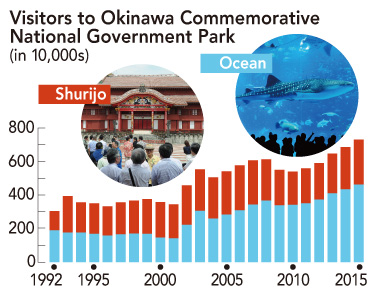
The total number of visitors to Okinawa Commemorative National Government Park (comprised of Ocean Expo Park and Shurijo Castle Park) in 2015 exceeded the total in the previous year by 6 percent at 7,280,784 visitors. This number has increased consecutively for the last 3 years. Bolstered by a rise in tourism in Okinawa, the Park has noticed the increased attendance throughout the year. On April 28, the Okinawa General Bureau announced the Park’s high attendance.
Visitors to Ocean Expo Park have increased in number for the past 4 years successively, reaching 4,607,961 in 2015 at a 6 percent rise from the year prior. Churaumi Aquarium, which has become the main attraction of Ocean Expo Park, noticed a 5.5 percent increase in patronage from the previous year at 3,408,521 visitors in 2015. The number of guests admitted to Churaumi Aquarium has risen for the second year in a row. The Okinawa International Orchid Show and other such events have had a positive effect on patronage to Ocean Expo Park.
Shurijo Castle Park marked a 6 percent rise in patronage at 2,672,823 people in 2015, the second highest number of people to have ever visited within a year. Visitors to the part of the park requiring admission fee payment rose 3.5 percent to 1,875,838 people, the third most to have entered this section within a year. Ryukyu dance demonstrations and other such exhibitions have boosted park attendance.
(English translation by T&CT and Erin Jones)
Go to Japanese
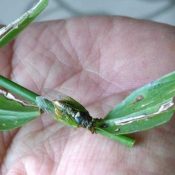
April 27, 2016 Ryukyu Shimpo
The smallest cicada in Japan, iwasaki kusazemi, was found buzzing on Yagaji Island in Nago City on April 22. Iwasaki kusazemi is a type of cicada, measuring about 1.5-2cm. The cicadas start buzzing around March or April every year.
The cicada was previously only known to inhabit Miyako and Yaeyama islands and a part of southern Okinawa Island, but 10 years ago, as the species started to expand its habitat to areas on Okinawa Island, it was confirmed that the cicadas also inhabit Yagaji Island.
Sixty-six year old Michio Taira of Nago City noticed the buzzing sound while he was planting flowers on Yagaji Island on April 22. As he looked around, he found the small cicada.
Taira said, “I was surprised that cicadas had started making noise this early and so I looked at trees nearby, and I found about 10 cicadas. I’ve never seen such small cicadas.”
A curator at the museum of the University of the Ryukyus, Takeshi Sasaki, speculated that the species has further expanded its habitat, “The cicada was found on Yagaji Island before, but there are some cases where the cicadas have been found in other areas in Nago City. Possibly the iwasaki kusazemi is flying and expanding its habitat.”
(English translation by T&CT and Sayaka Sakuma)
Go to Japanese
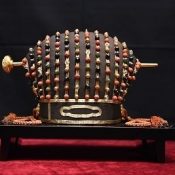
April 29, 2016 Ryukyu Shimpo
The Naha City Museum of History started displaying a national treasure from the Ryukyu Kingdom era, called “Tamamookanmuri (crown jeweled with balls),” on April 29. During the Ryukyu Kingdom era, kings wore the crown for ceremonies. The crown was displayed for the first time in two years. It will be open to the public until May 8. As well as the crown, Chinese attire worn by the Ryukyu kings is on display.
This is the only existing crown and appears to have been created in the 18th century. The crown is decorated with 24 balls each of gold, silver, jasper, and crystal on 12 golden bands. It also has a golden hairpin on which two dragons signifying the royal throne have been delicately inscribed.
Yoko Yamada, a museum staff member, said, “I want visitors to actually see the real crown and feel the weight of history.”
(English translation by T&CT)
Go to Japanese

April 29 2016 Ryukyu Shimpo
On April 28, a protest rally was held in the public square in front of the Okinawa Prefectural Government Office in Naha. When the San Francisco Peace Treaty came into force on April 28, 1952, Okinawa fell under the occupation of the U.S. military administration. The rally was held to mark the 64th anniversary of what was known as “a humiliating day.” According to the organizers, about 300 people took part, calling for the Japanese government to abolish new security laws and stop the discriminatory treatment of Okinawan people.
Hiroji Yamashiro, the director of the Okinawa Peace Movement Center, which organized the rally, highlighted that Prime Minister Shinzo Abe had held a ceremony to celebrate the restoration of Japanese sovereignty on April 28, 2013, and Okinawan people had opposed it. Yamashiro said, “We have to convey the anger of Okinawan people to the Japanese government in order to create a peaceful and prosperous society without military bases. We should overcome oppression by the government.”
Participants of the rally also demanded the government stop the offshore construction work for the relocation of U.S. Marine Corps Air Station Futenma to the Henoko district of Nago.
After the rally, the participants marched through Kokusai Street, decrying discrimination against Okinawans.
(English translation by T&CT)
Go to Japanese
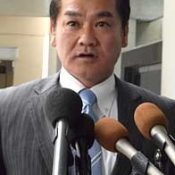
April 29, 2016 Ryukyu Shimpo
On April 27, during Mayor of Ginowan City Atsushi Sakima’s visit to the United States, he had successive discussions with the Senate Armed Services Committee (SASC) chairman John McCain (R-AZ) and SASC member Mazie Hirono (D-HI) on Capitol Hill. Mayor Sakima pointed out that despite the fact it has been 20 years since the agreement was made between the U.S. and Japan for Futenma Air Station to be returned to Japan, the return has not yet taken place. He said that, “Twenty years is a long time,” and, “It is important that the return [of Futenma] take place as soon as possible.”
At his discussion with Sakima, McCain emphasized that it is necessary to have the Futenma relocation facility constructed prior to returning Futenma to Japan. McCain also pointed out that resolving the Futenma relocation issue is a huge concern, and made clear that the U.S. intends to work with the Japanese government and Ginowan City to realize the return of Futenma.
Sakima finished everything on his schedule in order to make his appeal in Washington on April 27. In an interview he said that he was able to directly convey the frank opinions of Okinawan citizens to many Americans involved in the Futenma issue, and felt that being able to make his appeal heard in Washington was a great accomplishment. He also said, “My sentiment that we must achieve the return of Futenma [to Japan] has been strengthened.”
(English translation by T&CT and Erin Jones)
Go to Japanese
April 29, 2016 Ryukyu Shimpo
Japan’s State Minister for Foreign Affairs Seiji Kihara has said that he wants to urge the United Nations to amend and effectively withdraw a recommendation that describes Okinawans as an indigenous people and encouraged the Japanese government to protect Okinawan language, culture, and history.
Kihara claims that the UN recommendation “differs from the Japanese government’s position” and “does not accurately reflect the realities of our country.” However, a look at the modern and contemporary history of Ryukyu/Okinawa shows that Kihara’s position itself is highly problematic.
With the “Ryukyu disposition,” the Japanese government annexed the Ryukyu Kingdom using military force. At the time, the Ryukyu Kingdom was a sovereign state recognized under international law that had signed amity treaties with three other countries: the United States, France, and the Netherlands.
The Japanese government has avoided making a decision about whether it recognizes that the Ryukyu Kingdom was a sovereign state. Nonetheless, Kihara took it upon himself to urge the modification and withdrawal of the UN recommendation on the grounds that it “differs from the Japanese government’s position.” Does the Japanese government not need to clarify its position on the status of the Ryukyu Kingdom before a government official is able to make such a statement?
The designation of “indigenous peoples” referred to in the UN recommendation was developed by the United Nations and the international community to provide relief to minorities suffering from discrimination and human rights violations. The recommendation emphasizes the fact that Okinawan people were robbed of their land rights.
This is the fourth time the United Nations has recommended that Okinawans be recognized as an indigenous people. It is based on the reality of the Ryukyu disposition, acknowledges Japan’s subsequent rule over and oppression of Okinawa, and urges rectification of the situation. Such rectification would also apply to the human rights violations associated with the concentration of U.S. military bases in Okinawa.
Many different opinions exist regarding the term “indigenous people.” The Tomigusuku City Council has demanded withdrawal of the UN recommendation, saying that “Okinawans are Japanese, and are by no means an indigenous people.”
But the UN recommendation, which urges the government to deal with issues of discrimination based on a definition of “indigenous people” that focuses on protecting minorities and land rights, has validity. It should be respected, given the international community’s experience of fighting against colonial rule and for restoration of the right to self-determination. It is wrong-headed to criticize the recommendation based solely on narrow conceptions of race and ancestry.
To demand the modification and revocation of the recommendation is tantamount to announcing to the international community that Japan intends to ignore the structural discrimination that long caused Okinawa to suffer. It is rather the government’s duty to put the terms of the recommendation into practice and alleviate structural discrimination against Okinawa.
LDP Diet member Masahisa Miyazaki’s views are also problematic. In his question to Kihara, Miyazaki suggested that the UN recommendation “amounts to a plot to create ethnic divisions.” This assertion runs counter to the Okinawan people’s demand for relief from discrimination. It also shows a lack of understanding of Okinawa’s modern and contemporary history. Is his statement itself not a plot to create divisions among Okinawans?
(English translation by T&CT and Sandi Aritza)
Go to Japanese










 Webcam(Kokusai Street)
Webcam(Kokusai Street)


